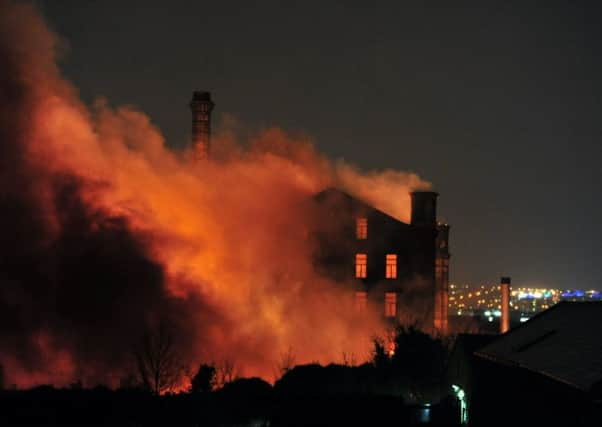Plea to rescue our troubled mills


The review by Historic England, entitled Securing Active and Sustainable Futures for the West Riding of Yorkshire’s Textile Mills, will collate details of the many successful mill conversions that have already taken place to create a best practice guide for future developments.
It comes as work continues to demolish the Drummonds Mill at Manningham, Bradford, which was destroyed by a huge fire last Thursday, and amid calls for a task force to be established to provide a strategic direction for the county’s troubled mills.
Advertisement
Hide AdAdvertisement
Hide AdHistoric England had been working with the owners of Drummonds Mill on its redevelopment plans and has described the fire at the 155-year-old former textile mill as “a crying shame”.
Trevor Mitchell, the planning director for Yorkshire at Historic England, said: “It was dreadful to see such a beautiful building on fire and to know that we have lost another historic Yorkshire mill.
“Our new study will give us a handle on how we can help the other mills which have not yet been regenerated and what needs to be done to turn them around.
“Yorkshire’s textile mills are the original Northern Powerhouse and we regard them as a very important asset.
Advertisement
Hide AdAdvertisement
Hide Ad“They are absolutely and distinctly Yorkshire and we need to make more of them.
“If you want a Yorkshire home that’s of the 21st century then a 19th century mill conversion can provide just that.”
Only four years ago Bradford Council rubber-stamped plans for a redevelopment of Drummonds Mill that would have created more than 100 apartments in the mill, which is now likely to be cleared to make room for new-build housing.
Historian Nigel Grizzard is urging the Government and local authorities to make it easier for mill owners to find new uses for some of the region’s most distinctive buildings.
Advertisement
Hide AdAdvertisement
Hide Ad“What happened with Drummonds Mill was a tragedy: there were loads of opportunities with the building but sadly the economics seem to have got in the way,” said Mr Grizzard.
“One hundred and fifty years of history went up in smoke overnight.
“Once these great buildings are gone, that’s it. There is a lot of good work taking place but it’s not enough.
“What we need is a strategy for West Yorkshire, where there are still hundreds, if not thousands of historic mills that need our attention. “
Advertisement
Hide AdAdvertisement
Hide AdDozens of Yorkshire mills and mill buildings, many of which had listed status, have been razed to the ground in recent decades and hundreds more face an uncertain future.
There have been many notable redevelopment successes with Yorkshire mills, including Salts Mill at Saltaire, Dean Clough in Halifax, and Listers Mill and Goitside in Bradford.
Mr Mitchell said: “There are plenty of examples of fantastic mill conversions into flats and apartments in places like Milnsbridge, Shipley, Leeds and Mirfield, which aren’t always high-value areas.
“Our hope is that the new study of the successful ones will help us see where any public funds can be better directed to secure the future of other mills.”
Historic England has appointed property consultants, Cushman and Wakefield, together with architectural practice, Lathams, to conduct the new survey into West Yorkshire mill buildings.